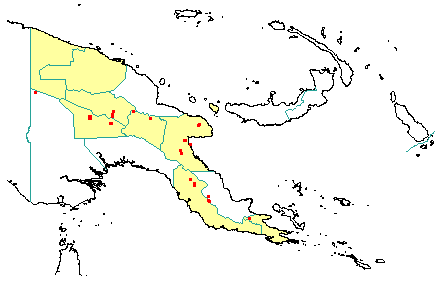
in PNGplants database
PNGTreesKey – Caldcluvia brassii (Schltr.) Hoogland |
Barry Conn (NSW) & Kipiro Damas (LAE).
Guide to trees of Papua New Guinea
Copyright held by the authors, National Herbarium of New South Wales, and Papua New Guinea National Herbarium
Blumea Vol. 25 (2): 484-485 (1979)
Other Literature: P. van Royen, The Alpine Flora of New Guinea 2 534-2 535 (1983)
Family: Cunoniaceae
Dicotyledon
Timber Group: Occasional timber species
Field Characters: Large canopy tree (15-25 m high) or Small sub-canopy tree (up to c. 10 m high, at higher altitudes); Bole cylindrical (up to 25 cm diam.); crooked (often branched from near base, bole up to 15 m long); buttresses buttresses absent; spines spines absent; aerial roots aerial roots absent; stilt roots stilt roots absent; Bark white, slightly rough or smooth, slightly pustular, lenticels elongated vertically; Subrhytidome (under-bark) brown; less than 25 mm thick, 10.0; bark blaze consisting of one layer; faintly to non-aromatic; outer blaze red, with stripes, fibrous or granular with splinters; inner blaze red, with stripes, fibrous or granular with splinters; bark exudate (sap) slightly present or absent, colourless, not readily flowing (spotty), colour not changing on exposure to air, not sticky (watery); terminal buds not enclosed by leaves.
Indumentum: Complex hairs present, star-like (stellate); stinging hairs absent; mature twig indumentum (hairs) present, hairs dense.
Leaves: Leaves spaced along branches, opposite (in pairs, opposite one another on the branchlet), compound (a leaf made up from two or more leaflets); petiole present, not winged, attached to base of leaf blade, at base swollen; leaves with three leaflets (trifoliate); petiolule at base swollen; leaves with a terminal leaflet (the number of leaflets odd - imparipinnate), broadest at or near middle or broadest below middle, 7.0-15.0 cm, 3.5-7.0 cm, leaflets opposite, symmetric, terminal developing leaflet buds straight; venation pinnate, secondary veins open, prominent, intramarginal veins absent; leaves lower surface green or brown (hairs brown), upper surface green, indumentum (hairs) present, indumentum (hairs) dense; absent; domatia absent; stipules present, joined, joined across twigs, not encircling the twig, leafy, not fringed (densely hairy), large (6-7 mm long), not persistent.
Flowers: Inflorescence terminal or axillary (in distal axils), flowers on a branched axis, cones absent; flowers bisexual (densely covered with reddish brown hairs), stalked (2 mm long), flowers with many planes of symmetry, 2.0-3.0 mm long, diameter small (up to10 mm diam.) (2-3 mm diam.); perianth present, with distinct sepals and petals whorls, inner perianth pink, red, or pale brown; 5 (early caducous), free; stamens 10, present, free of each other, free of the perianth; ovary superior, carpels joined (when more than one), locules 2; styles free, 2.
Fruits: Infrutescence arranged on branched axis, fruit 5.0 (c.) mm long, red or pale brown, not spiny, non-fleshy, simple, dehiscent, capsule; seeds 40 (c.), to about 5 mm long (2-2.5 mm long), winged, narrow (longer than wide), seed less than 1 mm diam. (c. 0.5 mm diam.).
Distribution: West Sepik, East Sepik, Morobe, Western Highlands, Eastern Highlands, Southern Highlands, Central & Milne Bay.
 | Botanical records in PNGplants database |